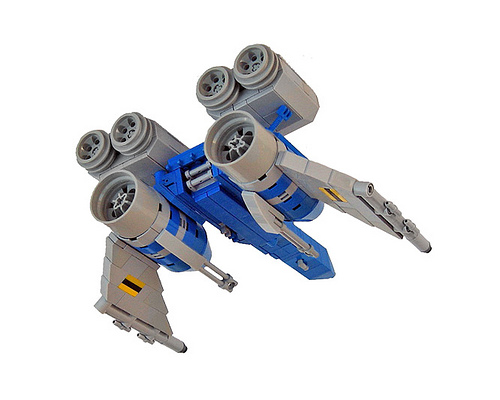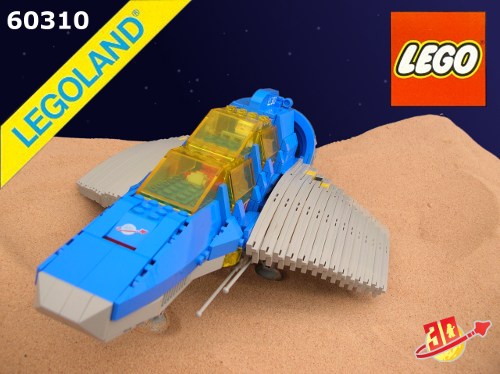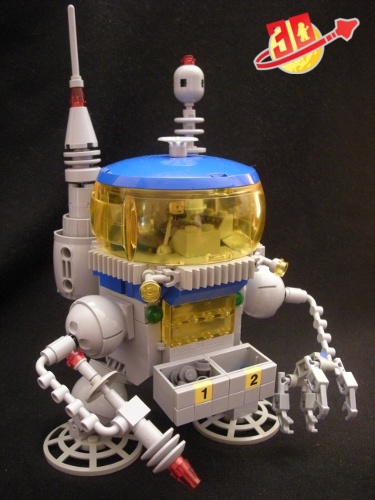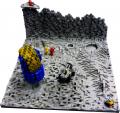neo classic space
Day 27: LL-077 Solar Enforcer
27 March, 2009 - 03:46 — jamesToday we catch up with the military arm of the Federation, and one of their "big guns", Mark Stafford's LL-077 Solar Enforcer.
The LL-077 was one of the most heavily armed ships of it's era. Capable of decimating ground targets and maneuverable enough to more then hold it's own in a dog fight with the emerging threat of Blacktron. It's only drawback was it's own firepower, if all guns were fired at a target straight ahead the ship it would stop it's own forward momentum after only 5 seconds of firing, and early test pilot often found themselves in negative spins.
Mark says: Face it, whatever the classic space ship looked like, to a kid of the 70's they looked something like this in our heads, bristling with guns and ready for action! Just like in that Star Wars movie or Battle Beyond the Stars! Hope you all like it!
Day 26 Bonus: LL-562 Defender
26 March, 2009 - 23:31 — jamesA small, fast, heavily armed starfighter, Peter L Morris's LL-562 looks very swooshable indeed.
Peter says: So, this is more along the lines of what was going through my mind when I was asked to do a MOC for NCS month. Don't get me wrong, I'm glad I went with the Seraph, but it's not exactly swoosh friendly. It can be swooshed, but the wings get in the way and tend to bump into things. Plus it's a pain to just set somewhere, as something ends up getting bent out of whack. This is more my speed. Simple landing gear, relatively tough, and not too terrible to look at.
Day 25 Bonus: Classic Space Channel 5
25 March, 2009 - 23:26 — jamesAnother great bonus at Miniland scale from Jason Railton.
"Hey there, space cats - Ulala here coming at you live on Classic Space
Channel 5. I'm right here on Starbase 059 where the Ugokin have just
boarded the station and seized control!"
"I'm waiting for my translator to relay their demands. They're telling
everyone to get down... get... get on down! People - I think they want
to DANCE!"
Day 25 Bonus: LL-009 Tactical Fighter
25 March, 2009 - 23:08 — jamesAnother amazing bonus from Nnenn, the LL-009, a slightly out dated model, but still a work-
Without various upgrades and additions, the ancient LL-009 would be completely dilapidated. Differences in ground crew over the years have kept any two ships from looking identical. And though an embarrassment to most pilots, at least Synths will fly them.
Day 25: Robot Command Center
25 March, 2009 - 00:34 — jamesNext in our whistle-stop tour of the Federation is Dan Rubin's Robot Command Centre, another vehicle designed to overcome the limitations of wheeled transport.
The Robot Command Center fills a role in the fleet that was left lacking for some time. Although we have mobile rocket-launching vehicles, we had no capability to maintain control once a rocket passed over the horizon, unless a ship was in the system. Now, we’re able to establish a command and control presence on a new world simply by depositing one or more of these babies on a planet. They are able to quickly establish a network of control, using the standard satellite rocket launched from the back. The Robot Command Centers also allow us to move our ground staff out of the way of alien weather systems.
Day 24 Bonus: Deep Space Transceiver
24 March, 2009 - 23:16 — jamesAs a bonus for good behaviour, we're allowed a brief visit to the Federation's SETI institute, thanks to Louise Dade.
The Federation S.E.T.I. Institute has been scanning deep space for signs of extra-terrestrial life and sending out their own signals since the mid-20th Century. Quite what they plan to do if they find anything hasn't been discussed. Not in public, anyway.
This dish (inspired by OptimalControl's) has an old-style 9v motor built into it (see it working) - which needed gearing down. A micromotor might have been better, but I didn't have a spare one.
Day 24: LL-136 Poulet Class Heavy Tug
24 March, 2009 - 00:43 — jamesToday's stop on our whistle-stop tour takes us to one of the Federation ship yards, where Ian Greig's LL-136 Poulet Class heavy tug is one the main workhorses, pulling heavy loads with the utmost precision.
The Poulet Class Heavy Tug is a mainstay of orbital construction yards, salvage depots and dockyards. A very utilitarian design, it is effectively two high power engines with a high-visibility cockpit mounted on top. Uniquely, the main engines are steerable, providing the pilot with precise control. The cockpit provides all-round visibility, whilst also offering the pilot high levels of protection, should things get out of hand.
They are often operated in teams of three or four; advanced automation systems allow one pilot to control upto four Poulet Class Heavy Tugsfrom the cockpit of one of the tugs, or remotely using a Remote Operation Console.
Day 23 Bonus: Special Ops Insertion Vehicle
23 March, 2009 - 23:12 — jamesAnother vehicle from the amazing Nnenn stable, the Special Ops Insertion vehicle is heavily armoured and able to carry troops to the most dangerous locations.
Only after losing all the Kronum colonies, did Federation forces discover a weakness in the most heavy armored Ugokin ground unit: an underside orifice housed directly beneath the weapons column. Good luck marines...
Day 23: LL-301 Falcon
23 March, 2009 - 00:18 — jamesToday our journey takes us to a ship that's so good, the science boffins decided to tell the military it was rubbish so they could keep it to themselves, Stuart Crawshaw's LL-301.
For over 100 years the Federation's main research arm has been the Advanced Spaceflight Technology Research Agency (ASTRA). The scientists and engineers of ASTRA undertake design, development and evaluation projects across a range of disciplines: dynamics, propulsion, communications, life support and many more. The LL-301 'Falcon' was an unexpected by-product of one such project: the flight trials of the EX130 dual-technology engine required a flying test-bed, which turned out to be such an exceptionally easy-to-fly ship that a limited production run was eventually commissioned, of which most are now in service with the scientific corps. An unarmed two-seat craft, the LL-301 is - unusually for a spaceship - suited to long periods of flight within a planet's atmosphere, thanks to the relatively high lift of its wings and the fuel-efficient EX130 which switches to a traditional turbojet mode whenever the atmosphere's density is high enough to support it.
Day 22: Retrobot
22 March, 2009 - 00:37 — jamesContinuing our trip through Federation space, we come across a couple of scientists, collecting samples with Shannon Sproule's Retrobot.
Although the Federation is well known for its vast array of wheeled vehicles, there are often situations where the train is too unforgiving for wheels. Flyers are, of course, invaluable, but prone to missing details that a ground vehicle would catch. The answer is, of course, legs.
The Retrobot is named by its crews for it's slightly old-fashoned appearance, even though they acknowledge it isn't actually a robot. Everyone is sure that they read its proper name in the manual once, but nobody seems to be able to find it. A two man survey vehicle, it has a fully presurised interior to provide a comfortable working environment. Remote manipulator arms are used for on the spot analysis and for loading samples into collector bins.





















